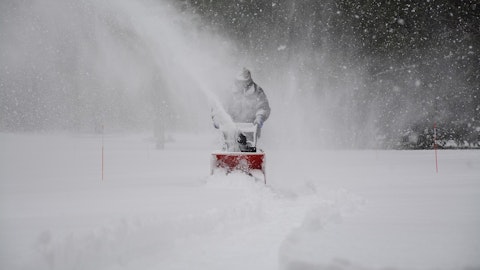Andy Wittmann: This whole strategy about kind of focusing in on the core and then exiting things that are seen as non-core. Obviously, the franchise transaction here subsequent to quarter end is a good example of that. I think you guys have also talked about some of your national account business is something that you’re looking at as well. And then there’s the whole just kind of basic thing of there’s some customers that you’re probably servicing right now that aren’t very profitable. So I guess, taken as a whole, maybe, Dale, could you talk about, one, a little bit more of the detail behind why franchise business was non-core and how that computes and what the thought process is on the national account business there too? Some of that business — I’m not talking to national account, I’m talking about externally serviced national account business, I think you call it BES or something like that.
Maybe you can talk about what that means and what kind of look that’s getting? And then where you are, how far along are you on portfolio customer review and exiting those customers, which really don’t give you the return or the profit margin that your services should deserve? Kind of a long question, but I think they’re all kind of thematically relevant together.
Dale Asplund : I think I’ve got them all weaved in my head, so let’s try to get through them, Andy. So first of all, why is the U.S. Lawns non-core to us. We are transforming this business and we are trying to develop better ways to support our branches and our sales force out in the field. Our U.S. Lawns’ non-core franchise business was getting all the benefits that we’re providing our branch managers by being part of our franchise network. Yet they really were not targeted at going after the same customer base. But over time, unfortunately, as they transitioned from some of the residential customers to more of the commercial, we began to see those direct franchisees competing against our local branches using the similar playbook and tool book, leveraging our estimating skills, leveraging our purchasing power to run their businesses.
That’s not what we want to do. We want to make sure that the investments we make to improve this business goes to the benefit of our branch managers and the branches out in the field. And the added value was, we were able to get a significant multiple above our trading level today to divest this business. So it was a great choice for us to divest an $11 million of revenue business and gets $52 million roughly for it. Now, the other area that you talked about; you classified it correctly. Not really national accounts. We still believe we can add huge value to our national account group, but more of the non-core business that we outsource, and we really act as a broker on. And we are an aggregator for customers to come to and then we work with local providers to provide that service.
There again, that business is going to fall into 1 or 2 buckets, and we’re evaluating this right now. It’s going to be a business that we want to self-perform, and we can add value and we can be the service provider and control the quality the customer gets. And the other part is going to be customers that we don’t target on a daily basis, and we’re 100% dependent upon those local providers to service the customer. That is too much of a risk for us, and we don’t want to jeopardize our relationship with big accounts that we don’t control the end service. So we are going to evaluate that aggregator business, and we’re going to decide how that will make sense for us on a go-forward basis. And we’ll give you guys everybody on the call an update at the end of Q2.
And that business today is broken into both snow and land. And we’re working with all those partners on snow this year, and then we’re making determinations on land, which will be coming up for the summer in most markets. So I think that hits 2 of them. Did you have another piece of it?
Andy Wittmann: Well, this whole idea of just portfolio review of your underlying customers and customer access, the whole idea of addition by subtraction. And anything you could do just to maybe clarify this one and make a little finer point. Is there a revenue number that like seems like a minimum that like just needs to not happen next year, and we should be thinking about in our models since we look at them?
Dale Asplund : Yes. Good question. I think I would just say, overall, with roughly, let’s just call it 50-50, 60-40, it depends on how much it snows. Our brokerage businesses, like we have said in the past, is roughly about $100 million. So — and we’ll give you an update on Q2. It gives you exactly how much we think we can self-perform and how much we’ll look at transitioning out. On the other larger accounts, I think our team has done a pretty good job continuing to mitigate some of the ones that has inflation work through the business, they weren’t priced right. So the team continues to make some progress there. We do have some larger contracts that were done at a time that maybe it wasn’t a focus to be profitable growth, and it was more to grow the business.
So we’ve done some adjustments, a few large municipal contracts with multiple years that we still have that we’ve got to work through. But I would tell you, Andy, we should be able to outrun that business just with our sales efforts that we’re doing. If we’re going to give you any headwinds from our revenue, it’s going to come really from that aggregator BES business that you mentioned. And we promise we’ll get through the snow season with our customers, and we’ll give a full update once our branches decide where and where they can best self-perform the work that we have. But great question.
Andy Wittmann: And then just my follow-up here. It has to do with snow. So you guys, obviously, December is what it was. To get to the low end of your guide, you need $170 million effectively here in the March quarter. And so I guess, as you sit here with a big snowstorm that hit through January, how much more do you need in these last 2 months to get to that low end?



